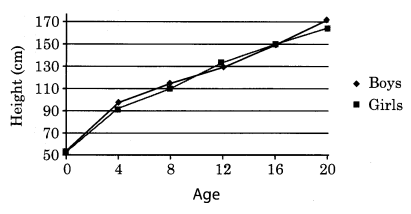Question 1.
What is the term used for secretions of endocrine glands responsible for changes taking place in the body?
Hormones
Question 2.
Define adolescence.
The period of life, when the body undergoes changes, leading to reproductive maturity, is called adolescence. The period of adolescence is normally 11 years to 19 years.
Question 3.
What is menstruation? Explain.
In females, the ova or eggs begin to mature with the onset of puberty (10 to 12 years of age) one egg get matured and is released by one of the ovaries once in about 28 to 30 days. During this period, the wall of the uterus becomes thick so as to receive the fertilized egg. In case it is fertilized, it begins to develop. This results in pregnancy. If the fertilization fails to take place, the ovum or the released egg and the thickened lining of the uterus along with its blood vessels are shed off. This causes bleeding in women. This is called menstruation. It occurs once in 28 to 30 days.
Question 4.
List changes in the body that take place at puberty.
The changes take place differently in the body of boys and girls at puberty. These change may be listed as below:
- There is sudden increase in the height of both boys and girls. However, both reach their maximum height at the age of 17 to 18 years.
- The voice of boys become hoarse and that of girls become shrill.
- Shoulders become broader and muscles grow more prominently in boys. In girls, the regions below the waist becomes wider.
- Hair start growing in different parts of boys and girls.
- In most of the teenagers, due to increased secretion of sweat and sebaceous gland, get acne and pimples on their face.
- Onset of puberty brings changes in secondary sexual characters in both male and female.
- Boys and girls become capable of reproduction.
- In girls, menstruation starts.
- Different types of hormones start to release in initiating a reproductive function.
Question 5.
Prepare a table having two columns depicting names of endocrine glands and hormones secreted by them.
| Endocrine glands | Hormones |
| 1. Pituitary gland | (i) Growth hormones |
| 2. Ovaries | (ii) Estrogen |
| 3. Testes | (iii) Testosterone |
| 4. Thyroid | (iv) Thyroxine |
| 5. Pancreas | (v) Insulin |
| 6. Adrenal glands | (vi) Adrenaline |
Question 6.
What are sex hormones? Why are they named so? State their function.
The hormones which help and control the formation of secondary sexual characters are called sex hormones. They are named so because they control the sexual activities and are secreted by males and females separately.
Functions of sex hormones are given below separately:
Male sex hormone: It is also called testosterone. It is secreted by testes and causes changes in secondary sexual character of boys like growth of facial hair like moustache, beard, etc. It also stimulates spermatogenesis.
Female sex hormone: It is also called estrogen. It is secreted by ovaries and controls the secondary sexual characters in females, appearance of mammary glands, etc. It also maintains pregnancy.
Question 7.
Choose the correct option.
(a) Adolescents should be careful about what they eat, because:
(i) proper diet develops their brains.
(ii) proper diet is needed for the rapid growth taking place in their body.
(iii) adolescents feel hungry all the time.
(iv) taste buds are well developed in teenagers.
(b) Reproductive age in women starts when their:
(i) menstruation starts.
(ii) breasts start developing.
(iii) body weight increases.
(iv) height increases.
(c) The right meal for adolescents consists of:
(i) chips, noodles, coke.
(ii) chapati, dal, vegetables.
(iii) rice, noodles and burger.
(iv) vegetable cutlets, chips and lemon drink.
(a) (ii)
(b) (i)
(c) (ii)
Question 8.
Write notes on:
(a) Adam’s apple
(b) Secondary sexual characters.
(c) Sex determination in the unborn baby.
(a) Adam’s apple: During puberty, a change in the voice of boys and girls takes place due to increase in the size of the voice box or larynx. In boys, the voice box tends to protrude out on the upper part of the neck, below the chin and is often referred to as Adam’s apple.
(b) Secondary sexual characters: Those characters which are visible more apparently and help in distinguishing a male from a female are called secondary sexual characters. For example, in girls, breasts and in boys, facial hair, i.e., moustache and beard.
(c) Sex determination in the unborn baby: The sex of a child, i.e., whether it is a male or a female is determined at the time of fertilisation when a male gametes fuse with a female gamete. All human beings have 23 pairs of chromosomes in the nuclei of their cells. Two chromosomes out of these are sex chromosomes. A female has two X chromosomes, while a male has one X and one Y chromosome. The gametes (egg and sperm) have only one set of chromosomes. The unfertilised egg always has one X chromosome.
But sperms are of two kinds—One having X chromosome, and the other having Y chromosome. When a sperm containing X chromosome fertilises the egg, the zygote would have two X chromosomes and develop into a female child. If the sperm contributes a Y chromosome to the egg or ovum at fertilisation, the zygote would develop into a male child. It is thus also clear that the sex chromosomes of the father determine the sex of an unborn baby.
Question 9.
Word game: Use the clues to work out the words.
Across:
3. Protruding voice box in boys
4. Glands without ducts
7. Endocrine gland attached to brain
8. Secretion of endocrine glands
9. Pancreatic hormone
10. Female hormone
Down:
1. Male hormone
2. Secretes thyroxine
3. Another term for teenage
5. Hormone reaches here through blood stream
6. Voice box
7. Term for changes at adolescence

Question 10.
The table below shows the data on likely heights of boys and girls as they grow in age. Draw graphs showing height and age for both boys and girls on the same graph paper. What conclusions can be drawn from these graphs?
| Age (Years) | Height (cm) | |
| Boys | Girls | |
| 0 | 53 | 53 |
| 4 | 96 | 92 |
| 8 | 114 | 110 |
| 12 | 129 | 133 |
| 16 | 150 | 150 |
| 20 | 173 | 165 |

From the above graph, we conclude that initially boys grow faster than girls from 0-8 years, and girls grow faster than boys from 8-16 years. But both reach their maximum height at the age of 20. Here boys show a greater increase in height than girls.
The following chart gives the average rate of growth in height of boys and girls with age. The figures in columns 2 and 3, give the percentage of the height a person has reached at the age given in column 1. For example, by the age 11, a boy has reached 81 % of this probable full height, while a girl has reached 88% of her full height. These figures are only representative and there may be individual variations.
Use the Table for your friends and work out how tall they are likely to be. Find out who is likely to be the tallest and who might be the shortest in your class.
| Age in Years | % of full height | |
| Boys | Girls | |
| 8 | 72% | 77% |
| 9 | 75% | 81% |
| 10 | 78% | 84% |
| 11 | 81% | 88% |
| 12 | 84% | 91% |
| 13 | 88% | 95% |
| 14 | 92% | 98% |
| 15 | 95% | 99% |
| 16 | 98% | 99.5% |
| 17 | 99% | 100% |
| 18 | 100% | 100% |
Question 11.
What is the other name for duct gland ?
Exocrine glands.
Question 12.
Name two duct glands.
Tear glands and sweat glands.
Question 13.
What are ductless glands ?
Ductless glands are those glands, from which the hormones are directly poured into the blood.
Question 14.
Name any two ductless glands.
Pituitary gland and thyroid gland.
Question 15.
Define hormones.
Hormones are secretions from endocrine glands.
Question 16.
Name a gland whose size gets reduced as the child grows older.
Thymus gland.
Question 17.
Name the hormone secreted by
- adrenal gland
- pancreas.
- Adrenalin
- Insulin.
Question 18.
Which gland secretes the hormone thyroxine ?
Thyroid gland.
Question 19.
Which gland is known as the master gland ?
Pituitary gland.
Question 20.
Name the female sex hormone and where is it produced ?
Estrogen is produced in the ovary.
Question 21.
Name the male sex hormone and where is it produced ?
Testosterone is produced in the testes.
Question 22.
What is the main function of the sex hormones ?
The main function of sex hormones is to control sexual characteristics.
Question 23.
Name the sex glands in male and female.
The sex glands are testes in male and ovaries in female.
Question 24.
Apart from estrogen, name the other female hormone secreted by ovaries.
Progesterone.
Question 25.
Which gland is responsible for the fatness in the body ?
Thyroid gland.
Question 26.
Which hormone causes sweating under fear ?
Adrenalin.
Question 27.
What do you understand by puberty ?
The age at which girls and boys attain reproductive maturity is known as puberty.
Question 28.
Which is the age of adolescence ?
The period of development from childhood to womanhood or manhood is the period of adolescence.
Question 29.
Where are hormones made in the human body ?
Endocrine or ductless glands.
Question 30.
What is menarche ?
The first menstrual flow is known as menarche.
Question 31.
Which is the prescribed marriageable age for boys and girls ?
Marriageable age for girls is 18 years and for boys is 21 years..
Question 32.
Which gland activates all other endocrine glands ?
Pituitary gland.
Question 33.
When does puberty end ?
Puberty ends when an adolescent reaches reproductive maturity.
Question 34.
What is menopause ?
Menopause is the stoppage of menstruation in woman.
Question 35.
At which age does menopause takes place ?
Menopause normally takes place between 45 to 50 years.
Question 36.
Name a gland which is exocrine as well as endocrine gland.
Pancreas..
Question 37.
How many chromosomes are present in each cell of humans ?
23 pairs, i.e., 46.
Question 38.
How many chromosomes are present in the nucleus of a single sperm ?
23 chromosomes.
Question 39.
How many chromosomes are present in the nucleus of a single egg ?
23 chromosomes.
Question 40.
Do all the eggs carry similar set of chromosomes ?
Yes, all eggs carry X – chromosomes.
Question 41.
Do all the sperms carry similar set of chromosomes ?
No, in some sperms 23rd chromosomes may be an X- chromosome and in some it may be a Y chromosome.
Question 42.
What are twins ?
Twins are two babies from a mother taking birth at the same time.
Question 43.
What is the term used for secretions of endocrine glands responsible for changes taking place in the body?
Sex glands.
Question 44.
Define adolescence.
The period of development from childhood to womenhood or manhood is the period of adolescence.
Question 45.
Choose the correct option :
- Adolescents should be careful about what they eat, because
- proper diet develops their brains.
- proper diet is needed for the rapid growth taking place in their body.
- adolescents feel hungry all the time.
- taste buds are well developed in teenagers.
- Reproductive age in women starts when their
- menstruation starts.
- breasts start developing.
- body weight increases.
- height increases.
- The right meal for adolescents consists of
- chips, noodles, coke.
- chapati, dal, vegetables.
- rice, noodles and burger.
- vegetable cutlets, chips and lemon drink.
- proper diet is needed for the rapid growth taking place in their body.
- menstruation starts.
- chapati, dal, vegetables.
Question 46.
Expand AIDS.
Acquired Immuno Deficiency Syndrome.
Question 47.
What name is given to adolescents in their teens ?
Teenagers.
Question 48.
What name is given to the period when a person is neither a child nor an adult ?
Teens.
Question 49.
Does the height of a person depend on his parents ?
Yes, the height of a person depends on the genes inherited from his parents.
Question 50.
Why does a person look tall at puberty ?
At puberty, the bones of .the arms and legs elongate and make a person tall.
Question 51.
Give the right word for :
- A hormone that helps in reproduction.
- A gland in the neck, which when swollen causes goitre.
- A hormone which helps to balance the suger in the body.
- An element without which thyroxine hormone is not formed. .
- Gonadotropin
- Thyroid
- Insulin
- Iodine
Question 52.
Distinguish between exocrine and endocrine glands.
Distinguish between exocrine and endocrine glands :
| Exocrine Glands | Endocrine Glands |
| (a) They secrete enzymes which come out through ducts. (b) e.g., salivary gland |
(a)They secrete hormones which are pushed directly into the blood. (b)e.g., adrenal gland. |
Question 53.
Name the glands
- which secrete juices
- which secrete hormones.
Give one example in each case.
- Exocrine glands, e.g., liver secretes bile.
- Endocrine glands, e.g., adrenal gland.
Question 54.
Why should adolescents eat a balanced diet ?
A balanced diet during adolescence helps in proper development of reproductive organs and a beautiful body.
Question 55.
What is “female foeticide” ?
Killing of the female foetus in the mother’s womb is known as female foeticide.
Question 56.
Which is the main change in boys at puberty ?
The most obvious change in body is the sudden increase in height. The person looks tall because the bones of the legs and arms suddenly become long.
Question 57.
What do you think is the main difference in the boys and girls of your class ?
In girls, there is more growth in the body parts below the waist. The boys have wider chest and shoulders.
Question 58.
What is the difference in the voice of boys and girls during adolescence ?
The voice of boys becomes hoarse and deep but the voice of girls become shrill but sweet during adolescence.
Question 59.
What is the difference in the reproductive activity of male and female humans ?
In male humans the reproductive activity is from puberty to 60 or 70 years.
In female humans the reproductive activity is from puberty to 45 to 50 years.
Question 60.
What do you understand by X and Y chromosomes ?
X chromosomes stand for female characters and Y chromosomes for male characters.
